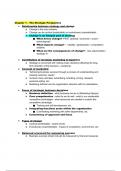Exam (elaborations)
Test Bank for Clayton’s Basic Pharmacology for Nurses 19th Edition By Michelle J. Willihnganz, Samuel L. Gurevitz, Bruce Clayton , ISBN: 9780323796309 | Chapters 1-48 | All Chapters with Answers and Rationals
- Course
- Institution
- Book
Test Bank for Clayton’s Basic Pharmacology for Nurses 19th Edition By Michelle J. Willihnganz, Samuel L. Gurevitz, Bruce Clayton , ISBN: 9780323796309 | Chapters 1-48 | All Chapters with Answers and Rationals
[Show more]




